ANCIENT EGYPTIAN MILITARY, BRUTALITY AND TERROR
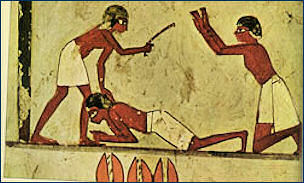
beating in ancient Egypt All and all, ancient Egypt wasn’t very warlike. The Egyptians seemed relatively content living in their unchanged world and did not embark on many campaigns of conquest and when they did their efforts seemed relatively half hearted. One reason Egypt was able to build such large temples and pyramids was that was relatively untroubled by wars and could devotes its manpower to construction projects rather than an army.
Compared to Mesopotamia, Egypt was not very advanced militarily. This was due in part to Egypt's relatively protected geographical position. Armies could not approach Egypt with passing through narrow corridors (the Nile Valley, north and south, and site of the present-day Suez canal) that were relatively easy to defend.
But this didn’t mean the ancient Egyptians were shy about using brutality and terror when it suited their purposes. In 1300 B.C., King Menephta meted out revenge on the Libyan army by severing their penises. A monument at Karnak reads: "Phalluses of Libyan generals — 6. Phalluses cut off Libyans — 6,359. Sirculians killed, phalluses cut off — 222. Etruscans killed, phalluses cut off — 542. Greeks killed, phalluses presented to the king — 6,111.
Pharaohs returning from naval campaigns sometimes displaying the dead bodies of enemy princes on the bows of their boats. One of the remaining walls at the Hypostyle Hall at Karnak contains an inscriptions reads: "His Majesty exults at the beginning of battle, he delights to enter it; his heart is gratified at the sight of blood. He lops off the heads of his dissidents...His majesty slays them at one stroke — he leaves them no heir, and whoever escapes his hand is brought prisoner to Egypt."
Mesopotamian Prisoners, Spies and Women and Children
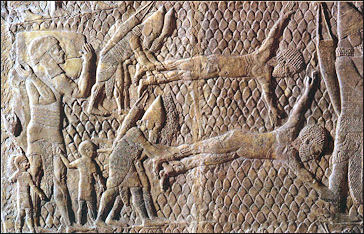
Assyrian flaying of rebels In ancient Mesopotamia prisoners of war were not used by the Sumerians as slaves but were deported to different part of the kingdom. Sometimes they were sacrificed in temples. It seems only men were killed in battles and sieges and in sacrificial rites not women or children. Historian Ignace Gelb has argued that this was so because it was "relatively easy to exert control over foreign women and children" and "the state apparatus was still not strong enough to control masses of unruly male captives." As the power of the state increased males prisoners were "marked and branded" and "freed and resettled" or used as mercenaries or bodyguards to the king.
Spies were called scouts, or eyes. They were often employed to check out what was going on in rival kingdoms. The following is an Akkadian text from one "brother" king to another, complaining he had released the scouts according to a deal that was made but had not been paid the ransom as promised: "To Til-abnu: thus says Jakun-Asar your "brother” previously about the scout's release you wrote to me. As for the scouts which came in my power I have released. That I have indeed released (them) you know, still you have not sent the money for ransom. Every since I began releasing your scouts, you have consistently not provided the money for ransom. I here — and you there — should (both) release!"
Elamites, the Destroyers of Mesopotamia
The Elamites (2400 B.C. 539 B.C.) were one of the great destroyers of Mesopotamian culture. They emerged in what is now southwestern Iran and established a capital named Susa. They periodically battled with the Sumerians and destroyed Ur in 2000 B.C. They remained on the scene long enough to sack Babylon in the 12th century B.C. and carry the slab with Hammurabi’s legal code (See Babylonians) back to Susa.
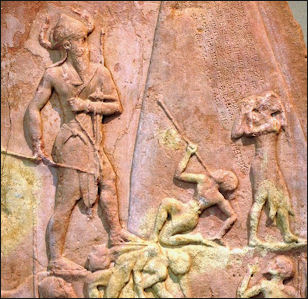
Akkadian Victory stelae
The Ur III empire founded by Ur-Nammu was overrun around 1950 B.C. by Elamites invading from the east, a disaster memorialized in haunting Sumerian laments:
Ur — inside there is death, outside there is death
Inside we succumb to famine
Outside we are dispatched by Elamite blades...
Oh your city! Oh your house! Oh your people!
Turmoil descended upon the land.
The statues that were in the treasury were cut down...
There were corpses floating in the Euphrates; brigands roamed the roads.”
An inscription describing its destruction went:
The great storm howls above...
In front of the storm fires burn;
the people groan...
In its boulevards, where the feats were celebrated.
scattered they lay...the people
lay in heaps..."
Assyrian Brutality and Terror
The Assyrians ruled Mesopotamia and much of the Near and Middle East from 883 to 612 B.C. At its height the Assyrian empire was centered in Nineveh, Iraq and encompassed what is now Iraq, Syria, Lebanon, Jordan, Israel, and Egypt and large parts of Turkey and Iran. For the Assyrians war was almost a business and they profited mightily from the rewards of conquest. The Assyrians began using iron weapons and armor in Mesopotamia around 1200 B.C. (After the Hittites but before the Egyptians) with deadly results. The also effectively employed war chariots. They were not the first to do this but they were the first to organize them into a cavalry.
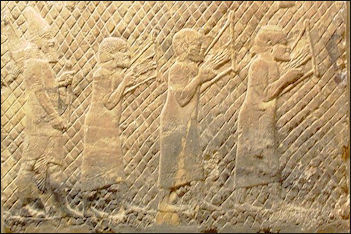
Assyrian prisoners The Assyrians established the largest army up to that time in the Mediterranean. Their armies had professional soldiers, infantry, charioteers, mounted archers, fast horses, engineers and wagoners. The most important unit was the royal bodyguard, perhaps the first regular army. The other units were amassed as need arose. In battles the Assyrians used bows, slings, iron swords and lances, battering rams, oil firebombs, but relied on iron javelins. Towns that refused to pay tribute were sacked. According to one tablet one town was “crushed like a clay pot” and the population and leaders were made prisoners “like a herd of sheep” as the Assyrian army carried away booty.
Lord Byron wrote that Assyrians went after their neighbors like a “wolf in the fold.” They forced captives to strip naked to show subservience to their captors and slaughtered those who dared to oppose them. Bas-reliefs from the Chaldean campaign (7th century B.C.) show Assyrian victors making piles of heads of their victims, using battering rams and impaling captives. Stone friezes at Nimrud and Ninevah show war chariots crushing enemy soldiers, women and children and an Assyrian king and queen enjoying drinks in a garden decorated with the head of an enemy leader dangling from a tree.
After one of his victories Assyrian King Ashurnasirpal bragged, "I cut off their heads; I burned them with fire; a pile of living men and of heads over against the city gate I set up; men I impaled on stakes; the city I destroyed...I turned it into mounds and ruin heaps; the young men and maidens I burned." Another Assyrian king boasted in 691 BC: "I cut their throats like sheep...My prancing steeds, trained to harness, plunged into their welling blood as into a river; the wheels of battle chariots were bespattered with blood and filth. I filled the plain with corpses of their warriors like herbage.”
The Assyrians reserved their wrath for the people who opposed them. Those that joined their empire were treated well. Among those that resisted the men were killed and the women and children was abducted and resettled in foreign land. The women were encouraged to take new husbands. Cuneiform tables reveal that refugees were given food, shoes, oil and clothes.
The art historian John Russell of the Massachusetts College of Art believes the Assyrian were no more warlike and brutal than other people of their time they were just better at it. He says that the brutal images are found mostly in throne room of Ashurnasirpal’s palace and were intended to intimidate visiting dignitaries. The rooms occupied by kings and queen had no such art. The adornments found there seemed to be there to ward off evil spirits.
Sun Tzu and the Art of War

Sun Tzu The Art of War is an influential book written by Sun Tzu, a famous Chinese general, 2,400 years ago, when pharaohs still ruled Egypt and the Greeks hadn’t yet achieved their Golden Age. Admired by Mao, Napoleon, Patton, Tony Soprano and many modern cooperate executives, it is a concise, 13-chapter, how-to guide on how to use military tactics to defeat one’s enemies. Admirers praise the book for its wisdom. Critics say its states the obvious. The book espoused ideas that for the most part had been around for a long time in a neat well-organized way.
Little is known about Sun Tzu, which literally means Master Sun. Tradition hold that he lived in the 6th or 5th century B.C., during the Spring and Autumn Period, and was born into an aristocratic military family. As a young man he became an adviser to the warlord of the state of Wu and helped him defeat his more powerful rivals from the state of Chu. The oldest known copy of The Art of War was written on bamboo strips sometime between 202 B.C. and A.D. 9.
Advice of Sun Tzu
"The art of war," wrote Sun Tzu, "is of vital importance to the state...a matter of life and death, survival or doom...Supreme excellence consists of breaking the enemy's resistance without fighting." To reduce bloodshed and avoid risk, Sun emphasized avoiding battles unless victory was assured and proposed that shows of force could produce the same outcome as actually fighting. Sun said the ablest leaders knew how to win without fighting.
But if war wasn't avoidable Sun Tzu argued that total war was the only way to go. And in going about that he advocated careful planning and preparation, good organization, exploiting an enemy’s weaknesses, and carefully picking the battles.
Sun Tzu said “War is a deceitful game” and advised using spies, disinformation, surprise attacks and sowing confusion among the enemy ranks. He advised armies to act strong when they were strong and act strong when they were weak and to be flexible and adapt battle plans as conditions change.
There are sections in The Art of War on troop deployment, political support, and using terrain, weather and diversions. One of Sun's favorite tactics was the use of incendiary attacks against people and equipment. "Fire starts best when the weather is dry," was one of his tips. He also suggested crying wolf again and again, lulling the enemy into complacency, and then striking hard with all you got.
Often repeated proverbs from The Art of War include : 1) “Know your enemy and know yourself, and in a hundred battles you will never face defeat”; 2) “Speed is everything...A army should move as fast as a gale” and “act as suddenly as a thunderclap.”
Romans Battle Tactics and Brutality

Greek Fire hand siphon The Romans fought differently than the Greeks. Instead of being organized into tight ranks like the Greeks, Roman soldiers organized themselves into small more maneuverable groups of soldiers called maniples , or handfuls. And instead of driving forward with thrusting spears and 70 pounds of armor, the Romans adopted light oblong shields and breast plates, and attacked with swords after unleashing a flurry of javelins, When they advanced disciplined foot soldiers marched relentlessly forward in centuries (blocks of shielded men). The Roman cavalry, which played a fairly big role in the 4th century B.C., was later reduced to auxiliary status. [Source: "History of Warfare" by John Keegan, Vintage Books]
The Roman legionnaires were more notorious for their brutality than the Greeks. The remnants of Alexander's armies were turned into dismembered corpses in a campaign in 199 B.C. According to one Roman historian soldiers were ordered by their superiors "to kill everyone they met and to spare no one, and not to start looting until they received their order. The purpose of this custom was to strike terror...not only human beings [were] slaughtered, but even dogs were sliced in two and the limbs of other animals were cut off." [Source: "History of Warfare" by John Keegan, Vintage Books]
Cities often surrendered before they could be slaughtered. Cicero said that “obeying rules of war and refraining from cruelty was what set men apart from beasts.” He was killed by Roman soldiers.
Greco-Roman Spies
Ben Macintyre of the Times of London wrote: “The Greek word for spook is the pleasingly anagrammatical skopos, and spies appear throughout Greek literature. In 405BC, for example, a Spartan spy at Aegospotami reported that the Athenians had failed to post a guard on the fleet, which was consequently attacked and destroyed. Like us, the Romans imagined they were too noble for the murky business of spying; but they came to accept that without a centralised intelligence system the future of the empire was in jeopardy.” [Source: Ben Macintyre, Times of London, October 9, 2010]
“Julius Caesar came, saw and conquered; and before that, he spied -- rather inadequately. In 55BC, the Romans were suffering from what would now be called a critical intelligence deficit. Caesar wanted to invade Britain but knew very little about the inhospitable island off the coast of Gaul. So Caesar launched a covert operation to gather information on British customs, harbours and military tactics. Caesar's first invasion was a failure, in large part because of inadequate and faulty intelligence. His internal spies used advanced techniques, including codes and ciphers, but he never did quite get the hang of intelligence.Moments before he was assassinated, a list of the conspirators was thrust into his hand, but he failed to act swiftly enough, and did not live to regret it.”
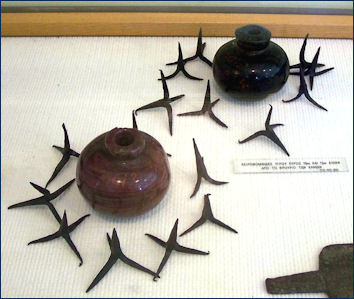
Byzantine liquid fire grenades
“Instead of sending out covert agents to report on neighbouring tribes, until about AD100 the Romans preferred to rely on huge defences, ad hoc military scouting in enemy territory and fides Romana, mutual trust between Rome and its allies, which sent word if barbarians approached. There was no lack of domestic espionage inside Rome: every aristocrat had a private network of agents and informers. Not until the 2nd century AD did Rome organise an agency that might be called a secret service. These were the frumentarii, ancestors of the CIA, KGB and MI6.”
“A cadre of supply sergeants whose original function was to collect and distribute grain, they combined the roles of tax collector, courier, secret policeman, political assassin and spy, and were generally loathed. Emperor Diocletian eventually disbanded the frumentarii, but they were immediately replaced by the agentes in rebus (general agents, a deliberately vague title), responsible for internal security and external intelligence. Their task, as defined by Procopius, was to “gain the most speedy information concerning the movements of the enemy, seditions . . . and the actions of governors and other officials”.”
“The Romans were as suspicious of the spy trade as we are, yet as the Roman world became increasingly unpredictable the future of that civilisation came to rest, in part, on the provision of good intelligence. Then, as now, spies occupied a contradictory position in society, feared but oddly glamorous, liable to corruption, regarded with mistrust by their political overlords but necessary for the security of the state. The 4th-century philosopher Libanius described the agentes as “sheepdogs who have joined the wolf pack”.”
The toga-and-dagger skulduggery of I, Claudius may seem distant and encrusted by myth, but in many ways the challenges of espionage and intelligence-gathering in the ancient world are similar to those facing the West today: distributing resources between conventional warfare and covert operations, policing internal sedition and reconciling the conflicting demands of secrecy and liberty. An intelligence agent could have no better training than a solid grounding in classics, Jonathan Evans, director-general of the British overseas spy agency MI5 told Iris, a magazine promoting Latin teaching in state schools: "I think that Sulla would have found a soul mate in some of the security chiefs I have met from despotic regimes elsewhere in the world." Evans is a classics graduate who utilized the insights of the Roman poet Juvenal, historian Suetonius, and Sulla, the Roman general with "the cunning of a fox" in his fight against al-Qaida.
Greek Fire and Flame Throwers

Greek fire catapult The Byzantines discovered that by adding sulphur or quicklime and saltpeter to naptha (asphalt-like petroleum) they could create a material capable of spontaneous combustion and produce bombs that could be thrown at enemies that would explode on impact. This napalm-like "Greek fire" was used in A.D. 673 and 678 to fend off attacks on Constantinople by Arabs.
In 10th century the Byzantines invented the flame thrower, a powerful secret weapon that changed the nature of warfare. The devise used Greek fire that was preheated under pressure and discharged in liquid form with pump-powered, syringe-like bronze tubes. It was used primarily in sea battles, when it incinerated wooden ships and their crews and even spread fire on the water. Russia's Prince Igo purportedly lost 10,000 vessels to Greek fire in a battle in 941.”
Fire weapons made Byzantine ships masters of the sea for centuries. Byzantine war ships were outfit with catapults used to fire "Greek fire" grenades and cannons. Greek Fire was also used on land: pressurized siphons were fired at forts, squirt guns and ceramic hand grenades were used at close range in hand-to-hand battles,
The recipe for Greek Fire was a carefully guarded secret. It is believed that early versions were devised by Callinicus, a A.D. seventh-century engineer from Syria, where people had been using flammable petrochemicals for some time. Scholars are still not sure of the ingredients. It was likely a highly combustible mixture of quicklime, sulphur, naptha and saltpeter. It was particularly nasty because it clung to whatever it touched and was not quenched by water. Clothing and ship sails were often ignited and people could not put out the fires by jumping into the sea.
The use of Greek Fire was regarded with horror and moral disgust. There is no mention of it from A.D. 800 and 1000 and some scholars believed it may have been banned because it was "too murderous."
Early Biological Weapons
In the 6th century B.C. Assyrians poisoned wells of enemies with the rye ergot fungus, which induced a diseases called ergotism. Symptoms included convulsions and gangrene, leading to death. [Source: Washington Post ]
In 1347, Tartars besieging Kaffa on the Black Sea catapulted corpses of plague victims into the city, where Genoese colonists gathered. Many city dwellers died. Some of the survivors escaped on ships returning to Genoa, carrying the plague with them.
In 1761, in the French and Indian War in colonial America, British soldiers under siege in Fort Pitt by Indian tribes, allied with France, gave the Indians blankets ostensibly as a friendly gesture. The blankets were infected with smallpox, and thousands of Indians died.
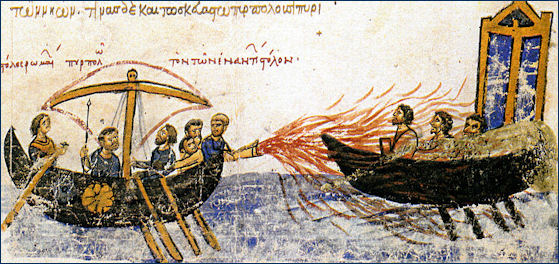
Greek fire, skylitzes
Early Jewish Militant Groups and Their Beliefs About a Messiah
Jesus was born at a time of social unrest when many Jews were interested in the coming of a Messiah. The unrest can be traced back to the Maccabean revolt in 167 B.C., a nationalist Jewish rebellion against Greek rulers. Many young Jewish men died as martyrs. The Maccabean revolt set off a long period of chaos, social upheaval and expectations of a Messiah.
Messiah literally means the “anointed one” in Hebrew, and was widely understood to mean “King of the Jews.” In Jesus’s time Jews regarded the ideal Messiah as a redeemer or Davidic king, who take the faithful to a peaceful world, far different from the chaotic one that people lived in at that time. As a consequence of this religion began to focus more on the destiny of the individual, meting out justice in way that righted injustice of the world and dealt with the afterlife. From out of this grew the concept of a Judgment Day, resurrection and salvation.
In 168 B.C., the Hasmoneans (Maccabees) carried a successful revolt against Antiochus Epiphanes of Syria, a tyrannical Greek King who led the Seleucid kingdom and attempted to destroy the Jewish religion and force the Jews to worship pagan idols. Many young Jewish men died as martyrs. The Hasmoneans led by the elderly Mattahias and his five sons captured Jerusalem and rededicated the Temple. The revolt is remembered through the holiday period of Hanukkah.
The Hasmoneans were a clan of pious and noble Jewish warriors that emerged from the area around Modiin near the border of Samaria and Judea (present-day Israel and the West Bank) . They established a Jewish kingdom that lasted from 168 to 63 B.C. During their brief rule they encouraged everyone to convert to Judaism. There was a long period of chaos, social upheaval and expectations of a Messiah. The Greeks decided to move out.
Jews, in Jesus's time, believed that the Messiah was more likely to be a strong military leader than a gentle, moralizing preacher. The prophet Isaiah predicting that the Messiah would be a "Prince of Peace" who conquered the Assyrians "like the mire of the streets," reduced Damascus to "a ruinous heap," transformed Babylon into a city inhabited only by owls, satyrs and other "doleful creatures," and in Egypt “turn everyone against his neighbor, city against city, and kingdom against kingdom." The prophet Jeremiah expressed similar sentiments. According to him, God said that the Philistines "shall cry and all the inhabitants of the land shall howl," the Egyptians "shall be satiate and made drunk with their blood," and the daughters of Ammon shall "be burned in fire" when the Messiah comes.
Essenes

Medieval vision of the
coming of the Jewish Messiah The Essenes were a breakaway, apocalyptic Jewish sect that lived around the Dead Sea. Regarded as the authors of the Dead Sea scrolls, they moved to the desert to await the Messiah and believed in baptism and redemption. Since their monasteries were so close to John's baptismal site many believe they were early purveyors of Christianity. Most everything that is known about the Essenes has been derived from the Dead Sea scrolls.
The Essenes believed that they had been chosen to fight the "sons of darkness" as end of the world approached. They founded the earliest known monasteries and were led by leader called the Teacher of Righteousness. Their calendar was different from that of mainstream Jewish sects associated with the Temple of Jerusalem. They were highly secretive and conducted ritual bathes. Many lived in manmade caves dug into marl. Excavations by archaeologists of numerous bathing facilities at the Dead-Sea-scroll of Quamran suggests that these proto-Christians practiced baptism.
The Essenes allowed couples to live together without marriage. The relationship was only solemnized if the woman became pregnant. The Essenes may have influenced some of Jesus' teachings. The sect preached the idea of salvation but only to a few, not all of humanity like Jesus did. The Essenes were conquered in A.D. 68 by the Romans.
Jewish Guerilla Movements
At the time of Jesus's birth, the Holy Land was crawling with militant Jewish groups engaged in a prolonged guerilla-style warfare against the Roman army. The districts of Palestine, where Jesus lived and worked were major centers of insurgent activity. In the first century AD, the Zealots and Sicarii, two Jewish sects, attacked the Roman occupiers of Judaea and their allies in public places.
Militants Jewish groups and “bandit-guerrillas” were active in the decades before the birth of Christ and they continued being active decades after his death until a full scale Jewish revolt in A.D. 68 when a leader named Manahem took control of the temple area by driving out the Roman troops and executing the high priests. Six Roman legions were required to put the revolt down. Josephus chronicled five major Jewish military messiahs, not including Jesus or John the Baptist, between 40 B.C. and A.D. 73.
The Romans referred to the Jewish insurgents as bandits even though most of their targets were absentee landlords and tax collectors. They were also sometimes called "zealots" (a reference to their zeal for Jewish law and the promise of God's covenant). Bandit-guerrillas who were caught were often crucified or beheaded in public.
Tactics of Jewish Guerilla Movements
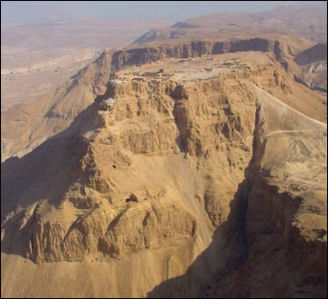
Masada The zealot-bandits practiced guerilla tactics that would have made Mao proud: they seized armories, staged hit and run attacks and assassinations and carried out suicide mission and terrorist attacks on the palaces of important leaders. Many of the fighters lived in caves or mountain hideouts. Some urban guerilla fighter were known as "dagger men," because they carried knives in the folds of their robes.
From time to time these guerilla leaders lead uprisings that were quickly dashed by the Roman military. Herod made a name for himself by ambushing two threatening Jewish leaders. One leader was executed in front of a cave in full view of his wife and seven children. In 4 B.C. Jews angry over the execution of students caught trying to remove a Roman eagle from temple decoration launched a city-wide riot. Eventually some 2,000 Jews were crucified.
A violent protest broke out over the Roman transgression of the Jewish taboo on graven images and the use of temple funds to build an aqueduct to supply the Romans with water for their bathes. During a Passover feast in 50 A.D. a Roman centurion raised his tunic and farted into a group of pilgrims. "The less restrained of the young men and the naturally tumultuous segments of the people rushed into battle," Josephus reported. The Roman infantry was called in and Josephus claimed 30,000 people were trampled to death.
The rebels had a few victories. In A.D. 26, Jews confronted Roman soldiers over the raising of a flag with Caesar’s face near the central shrine of The Temple. The Jews bared their necks and dared the Romans to attack them. The result: the flags were taken down.
Jewish Revolts and Wars
There were many uprisings by the Jews during the period of Roman rule. In the A.D. 1st century there were conflicts between the Essenes, the Pharisees and the Hellinized priests that ruled the Temple. Messianic fervor led to several uprisings that eventually forced the Romans to put down two major Jewish revolts, in A.D. 70 and A.D. 125, the destroy the Jewish Temple and disperse the Hebrew population. It has been suggested that if the Jews hadn’t revolted there would have been no Jewish diaspora and history would have been very different.
The Sicarii were a first century Jewish group who murdered enemies and collaborators in their campaign to oust their Roman rulers from Judea. In A.D. 66, there was a Jewish revolt at Herod's Temple in Jerusalem. At that time bandit-guerrillas were at the height of their power and they were everywhere. A leader named Manahem took control of the temple area by driving out the Roman troops and executing the high priests. The same year there was also a major revolt in Caesara that led to the death of 20,000 people, nearly all of the Jews that lived in the city.
In A.D. 64, Nero blamed the great fire of Rome on the Jews. Shortly afterwards there was a Jewish revolt that lasted from A.D. 66 to 73. Six Roman legions (35,000 men), Rome's most modern weaponry and siegecraft, and the leadership of two future Roman emperors to put down. Nero dispatched Vespasian and a large Roman force to Judea (Israel) to put down the rebellion. Halfway through the war Nero was overthrown and Vespasian was proclaimed emperor by the Roman army. Nero died in A.D. 68, when the Jewish revolt had escalated. Vespasian didn’t last long. He was succeeded by his son Titus, who ended the Jewish uprising by sacking Jerusalem and destroying the Jewish Temple.
Image Sources: Wikimedia Commons
Text Sources: New York Times, Washington Post, Los Angeles Times, Times of London, The Guardian, National Geographic, The New Yorker, Time, Newsweek, Reuters, AP, AFP, Wall Street Journal, The Atlantic Monthly, The Economist, Global Viewpoint (Christian Science Monitor), Foreign Policy, Wikipedia, BBC, CNN, NBC News, Fox News and various books and other publications.
Last updated July 2012
